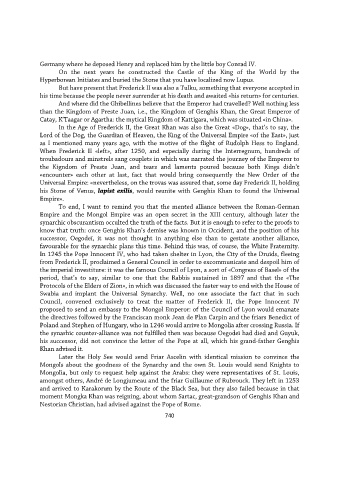Page 740 - Microsoft Word - Belicena respaldo
P. 740
Germany where he deposed Henry and replaced him by the little boy Conrad IV.
On the next years he constructed the Castle of the King of the World by the
Hyperborean Initiates and buried the Stone that you have localized now Lupus.
But have present that Frederick II was also a Tulku, something that everyone accepted in
his time because the people never surrender at his death and awaited «his return» for centuries.
And where did the Ghibellines believe that the Emperor had travelled? Well nothing less
than the Kingdom of Preste Juan, i.e., the Kingdom of Genghis Khan, the Great Emperor of
Catay, K’Taagar or Agartha: the mytical Kingdom of Kattigara, which was situated «in China».
In the Age of Frederick II, the Great Khan was also the Great «Dog», that’s to say, the
Lord of the Dog, the Guardian of Heaven, the King of the Universal Empire «of the East», just
as I mentioned many years ago, with the motive of the flight of Rudolph Hess to England.
When Frederick II «left», after 1250, and especially during the Interregnum, hundreds of
troubadours and minstrels sang couplets in which was narrated the journey of the Emperor to
the Kigndom of Preste Juan, and tears and laments poured because both Kings didn’t
«encounter» each other at last, fact that would bring consequently the New Order of the
Universal Empire: «nevertheless, on the trovas was assured that, some day Frederick II, holding
his Stone of Venus, lapist exilis, would reunite with Genghis Khan to found the Universal
Empire».
To end, I want to remind you that the mented alliance between the Roman-German
Empire and the Mongol Empire was an open secret in the XIII century, although later the
synarchic obscurantism occulted the truth of the facts. But it is enough to refer to the proofs to
know that truth: once Genghis Khan’s demise was known in Occident, and the position of his
successor, Oegodeï, it was not thought in anything else than to gestate another alliance,
favourable for the synarchic plans this time. Behind this was, of course, the White Fraternity.
In 1245 the Pope Innocent IV, who had taken shelter in Lyon, the City of the Druids, fleeing
from Frederick II, proclaimed a General Council in order to excommunicate and despoil him of
the imperial investiture: it was the famous Council of Lyon, a sort of «Congress of Basel» of the
period, that’s to say, similar to one that the Rabbis sustained in 1897 and that the «The
Protocols of the Elders of Zion», in which was discussed the faster way to end with the House of
Swabia and implant the Universal Synarchy. Well, no one associate the fact that in such
Council, convened exclusively to treat the matter of Frederick II, the Pope Innocent IV
proposed to send an embassy to the Mongol Emperor: of the Council of Lyon would emanate
the directives followed by the Franciscan monk Jean de Plan Carpin and the friars Benedict of
Poland and Stephen of Hungary, who in 1246 would arrive to Mongolia after crossing Russia. If
the synarhic counter-alliance was not fulfilled then was because Oegodeï had died and Guyuk,
his successor, did not convince the letter of the Pope at all, which his grand-father Genghis
Khan advised it.
Later the Holy See would send Friar Ascelin with identical mission to convince the
Mongols about the goodness of the Synarchy and the own St. Louis would send Knights to
Mongolia, but only to request help against the Arabs: they were representatives of St. Louis,
amongst others, André de Longjumeau and the friar Guillaume of Rubrouck. They left in 1253
and arrived to Karakorum by the Route of the Black Sea, but they also failed because in that
moment Mongka Khan was reigning, about whom Sartac, great-grandson of Genghis Khan and
Nestorian Christian, had advised against the Pope of Rome.
740

